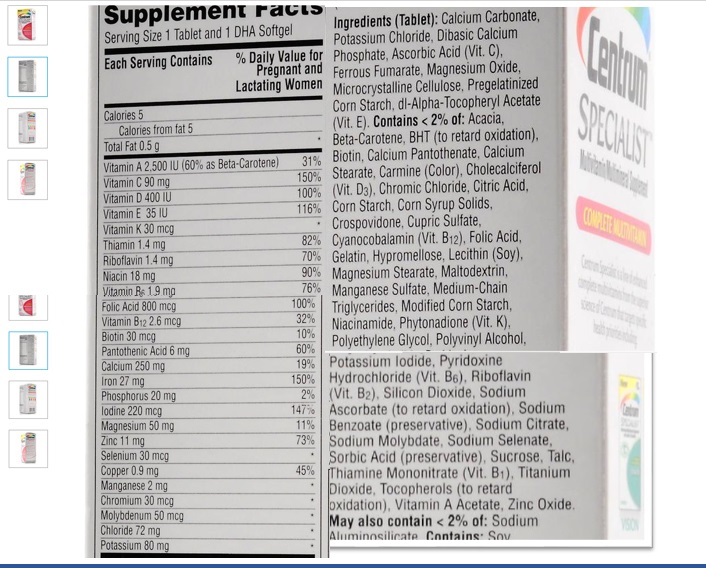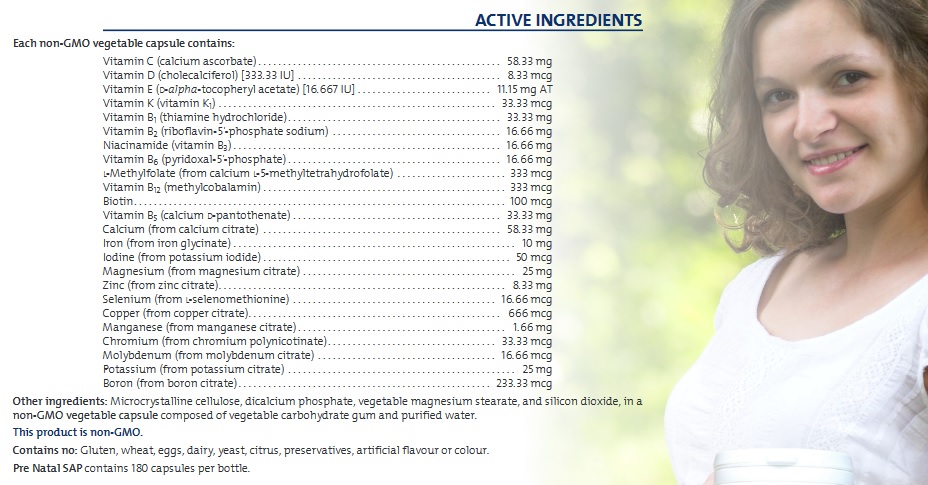Why Use a 3x/day Prenatal Multi-vitamin?
I had a difficult time answering the above question (asked from a mom-to-be) in a concise, efficient and easy to understand one liner. Medical topics can rarely be summarized into one-liners, and if they are, know that you aren’t getting the full picture but rather a bell-curved answer that has satisfied most.
The idea of a one-a-day prenatal vitamin is exactly that: a bell-curved answer that satisfies most health practitioners’ worries about vitamin deficiencies linked to birth defects. My goal as a health practitioner however isn’t merely to prevent birth defects; it is to optimize health!
Let’s compare the commonly used prenatal found at most drug stores, Centrum with one more commonly recommended by Naturopathic Doctors from the company NFH.
Here are THREE very important differences (see images below for package details):
- The vitamins and especially the minerals present in Centrum are in the lowest quality chemical forms (not absorbed, not used by body =waste). Some examples…
- Although Centrum contains a higher amount of Iron (27mg), the form it’s in is not absorbed as well as the form used in NFH (10mg). In one study, ferrous glycinate 25 mg (used in NFH) was not found inferior to ferrous sulfate 50 mg (similar to form used in Centrum) and appeared to be adequate to prevent iron deficiency anemia in Danish women during pregnancy and postpartum in a study. [1] As you can see, a 25 mg dose of the better form is equivalent to a 50 mg dose of the lower quality form. Plus, when you take 3 caps a day of the better form, you would get more than the mg dose in the one-a-day (27mg in Centrum vs. 30 mg in NFH).
- When it comes to folic acid, due to the MTHFR genetic defect found in one in two people (half of the population) -not made apparent unless through a genetic test- there’s ineffective conversion of folic acid to its active form (l-Methylfolate). In the case of an MTHFR mutation, an inability to process folic acid can have serious effects. For one, a developing fetus can suffer brain defects like spina bifida or anencephaly if the mother has a severe defect in the gene. Folate deficiency can also result in lethargy, impaired cognitive function, and mood disorders in an otherwise healthy and non-pregnant individual. [2] [3] NFH has bypassed this potential genetic defect by including the active form of folic acid (l-methylfolate) in its prenatal.
- It is generally known and well accepted that the mineral forms of calcium and magnesium are best absorbed in the citrate form. As you may already be aware the form of magnesium, oxide as used in Centrum, is generally used as a stool softener due to its ability to absorb water and pass through the digestive system unabsorbed. As well, calcium carbonate’s rate of absorption is 22% to 27% less than than of calcium citrate. [4] Centrum provides 250 mg calcium and 50 mg magnesium per capsule. This is a 5:1 ratio of calcium to magnesium. A daily total of NFH’s prenatal would provide about 170mg of calcium and 75 mg of magnesium. As discussed, not only is NFH’s form more bioavailable leading to more of these minerals being absorbed through your digestive tract, the more appropriate ratio of approximately 2:1 would ensure proper mineralization and prevent hypercalciuria and kidney stones. [5]
- Apart from the chemical differences, another important factor is that supplementation in tablet form is generally understood as ‘flushing your money down the toilet’ :D A number of studies looking at tablet dissolution have found that most tablets do not fully dissolve in the digestive tract and pass through fully and/or partially unabsorbed. Capsules on the other hand break open a lot more efficiently by the digestive juices and release their content making them more readily available for absorption.
- Lastly (for the purpose of this post), your digestive tract has transporters and cellular ‘doors’ that allow vitamins and minerals to pass from the digestive tract to the circulatory system. Each of these doors and transporters has a threshold, which once met, the door to absorption is closed! Therefore, even in the best case scenario of a capsule made up of the best absorbed form of vitamins and minerals, WHEN taken in a single dose, will result in the absorption of only a certain percentage of each vitamin & mineral! Whereas, dividing up your total dose, over the course of the day allows for the maximal absorption by these intestinal “doors”.
word of caution: You may be thinking “I’ll just take my current one-a-day prenatal 3x/a day to finish it before I invest in a better quality prenatal”. You cannot! It is extremely dangerous to take more than one of such supplements; they contain certain vitamins (eg. Vitamin A) in quantities that would quickly reach toxic levels with >1x/day supplementation.
Although I can further describe reasons for the superiority of a 3-a-day prenatal over a 1-a-day prenatal, the above are some of the most important factors for this difference. Companies such a Centrum are answering a need for convenience and ease. However their solution is veiled by some serious lack of science! The convenience comes with the price of quality and waste of your hard-earned money.


I hope I’ve answered most expectant mothers’ questions with regards to differences in supplementation. If a one-a-day is all you can manage, there are a number of quality options available that far exceed Centrum -and the likes’- quality. Consult your naturopathic practitioner for more options.
Yours In Health,
Dr. Negin Misaghi, ND
References:
-
Milman N, Jønsson L, Dyre P, Pedersen PL, Larsen LG. Ferrous bisglycinate 25 mg iron is as effective as ferrous sulfate 50 mg iron in the prophylaxis of iron deficiency and anemia during pregnancy in a randomized trial. J Perinat Med. 2014 Mar;42(2):197-206.
-
Ramos Ml, Allen LH, Mungas DM, Jagust WJ, Haan MN, Green R, Miller JW. Low folate status is associated with impaired cognitive function and dementia in the Sacramento Area Latino Study on Aging.American Journal of Clinical Nutrition. 2005 December;82(6):1346-52.
-
Williams E, Stewart-Knox B, McConville C, Bradbury I, Armstrong NC, McNulty H. Folate status and mood: Is there a relationship?Public Health Nutrition. 2008 February;11(2):118-23.
-
Sakhaee K1,Bhuket T, Adams-Huet B, Rao DS. Meta-analysis of calcium bioavailability: a comparison of calcium citrate with calcium carbonate. Am J Ther. 1999 Nov;6(6):313-21.
-
Celotti F1,Bignamini A. Dietary calcium and mineral/vitamin supplementation: a controversial problem. J Int Med Res. 1999 Jan-Feb;27(1):1-14.

